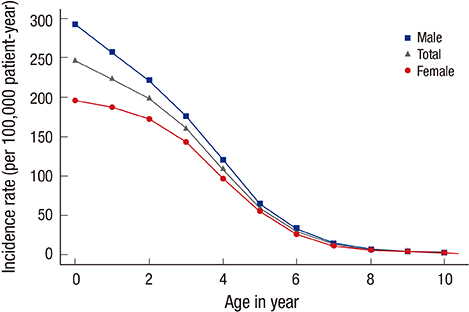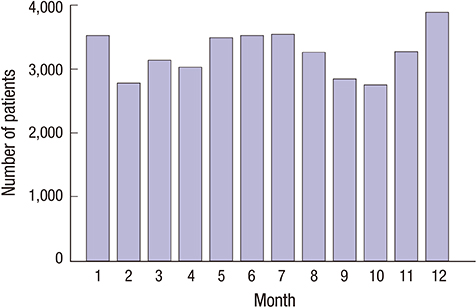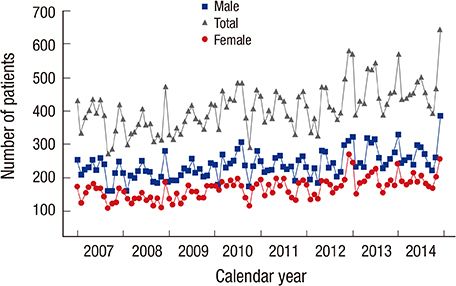J Korean Med Sci.
2016 Sep;31(9):1445-1449. 10.3346/jkms.2016.31.9.1445.
Epidemiologic Study on Kawasaki Disease in Korea, 2007-2014: Based on Health Insurance Review & Assessment Service Claims
- Affiliations
-
- 1Healthcare Review and Assessment Committee, Health Insurance Review & Assessment Service, Seoul, Korea. hsm150101@gmail.com
- 2Department of Pediatrics, Severance Children's Hospital, Yonsei University, Seoul, Korea.
- KMID: 2468278
- DOI: http://doi.org/10.3346/jkms.2016.31.9.1445
Abstract
- The aim of this study is to assess the actual epidemiologic features of Kawasaki disease (KD) in Korea using the data from Health Insurance Review & Assessment Service (HIRA) claims from 2007 to 2014. We investigated HIRA claims of patients who had KD (International Classification of Diseases-10, M30.3) as a major diagnosis and were given intravenous immunoglobulin (IVIG) from 2007 to 2014. A total of 39,082 patients were reported during the period. The male-to-female ratio was 1.42 and the median age was 28 months. The incidence rates were 168.3 per 100,000 population aged 0 to 4 years in 2007, 159.1 in 2008, 167.3 in 2009, 190.4 in 2010, 188.2 in 2011, 190.2 in 2012, 210.4 in 2013 and 217.2 in 2014. These rates were much higher than those in the previous studies in Korea. KD occurred more often in early summer (May, June and July) and winter (December and January). The annual incidence rate of KD had been increasing every year, reaching 217.2 per 100,000 population aged 0 to 4 years in 2014. It is the second highest incidence rate of KD in the world after Japan.
Keyword
MeSH Terms
Figure
Cited by 2 articles
-
Variants in the Gene EBF2 Are Associated with Kawasaki Disease in a Korean Population
Yoonsun Bae, Dongjik Shin, Jiho Nam, Hye Rim Lee, Jun Sung Kim, Kyu Yeun Kim, Dong Soo Kim, Yeun-Jun Chung
Yonsei Med J. 2018;59(4):519-523. doi: 10.3349/ymj.2018.59.4.519.Analysis of Circular RNAs in the Coronary Arteries of Patients with Kawasaki Disease
Young-Kook Kim
J Lipid Atheroscler. 2019;8(1):50-57. doi: 10.12997/jla.2019.8.1.50.
Reference
-
1. Kawasaki T. Acute febrile mucocutaneous syndrome with lymphoid involvement with specific desquamation of the fingers and toes in children. Arerugi. 1967; 16:178–222.2. Taubert KA. Epidemiology of Kawasaki disease in the United States and worldwide. Prog Pediatr Cardiol. 1997; 6:181–185.3. Makino N, Nakamura Y, Yashiro M, Ae R, Tsuboi S, Aoyama Y, Kojo T, Uehara R, Kotani K, Yanagawa H. Descriptive epidemiology of Kawasaki disease in Japan, 2011-2012: from the results of the 22nd nationwide survey. J Epidemiol. 2015; 25:239–245.4. Nakamura Y, Yashiro M, Uehara R, Sadakane A, Tsuboi S, Aoyama Y, Kotani K, Tsogzolbaatar EO, Yanagawa H. Epidemiologic features of Kawasaki disease in Japan: results of the 2009-2010 nationwide survey. J Epidemiol. 2012; 22:216–221.5. Nakamura Y, Yashiro M, Uehara R, Oki I, Watanabe M, Yanagawa H. Epidemiologic features of Kawasaki disease in Japan: results from the nationwide survey in 2005-2006. J Epidemiol. 2008; 18:167–172.6. Kim GB, Han JW, Park YW, Song MS, Hong YM, Cha SH, Kim DS, Park S. Epidemiologic features of Kawasaki disease in South Korea: data from nationwide survey, 2009-2011. Pediatr Infect Dis J. 2014; 33:24–27.7. Park YW, Han JW, Hong YM, Ma JS, Cha SH, Kwon TC, Lee SB, Kim CH, Lee JS, Kim CH. Epidemiological features of Kawasaki disease in Korea, 2006-2008. Pediatr Int. 2011; 53:36–39.8. Park YW, Han JW, Park IS, Kim CH, Cha SH, Ma JS, Lee JS, Kwon TC, Lee SB, Kim CH, et al. Kawasaki disease in Korea, 2003-2005. Pediatr Infect Dis J. 2007; 26:821–823.9. Park YW, Han JW, Park IS, Kim CH, Yun YS, Cha SH, Ma JS, Lee SB, Kim CH, Lee HJ, et al. Epidemiologic picture of Kawasaki disease in Korea, 2000-2002. Pediatr Int. 2005; 47:382–387.10. Park YW, Park IS, Kim CH, Ma JS, Lee SB, Kim CH, Yun YS, Lee HJ, Lee SK, Tockgo YC. Epidemiologic study of Kawasaki disease in Korea, 1997-1999: comparison with previous studies during 1991-1996. J Korean Med Sci. 2002; 17:453–456.11. Park YW, Kim CH, Park IS, Ma JS, Lee SB, Kim CH, Yun YS, Lee KS, Lee SK, Tockgo YC. Epidemiologic study of Kawasaki disease in Korea, 1994-1996: comparison of previous study in 1991-1993. J Korean Pediatr Soc. 1999; 42:1255–1260.12. Park JS, Seo CJ, Cho SH, Lee DB. Clinical observation of mucocutaneous lymph node syndrome: 5 cases. J Korean Pediatr Soc. 1973; 16:61–67.13. Lee DB. Epidemiologic study of Kawasaki disease in Korea. Prog Clin Biol Res. 1987; 250:55–60.14. Huang WC, Huang LM, Chang IS, Chang LY, Chiang BL, Chen PJ, Wu MH, Lue HC, Lee CY; Kawasaki Disease Research Group. Epidemiologic features of Kawasaki disease in Taiwan, 2003-2006. Pediatrics. 2009; 123:e401–5.15. Chang LY, Chang IS, Lu CY, Chiang BL, Lee CY, Chen PJ, Wang JT, Ho HN, Chen DS, Huang LM; Kawasaki Disease Research Group. Epidemiologic features of Kawasaki disease in Taiwan, 1996-2002. Pediatrics. 2004; 114:e678–82.16. Du ZD, Zhao D, Du J, Zhang YL, Lin Y, Liu C, Zhang T; Beijing Kawasaki Research Group. Epidemiologic study on Kawasaki disease in Beijing from 2000 through 2004. Pediatr Infect Dis J. 2007; 26:449–451.17. Du ZD, Zhang T, Liang L, Meng X, Li T, Kawasaki T, Nakamura Y, Yanagawa H. Epidemiologic picture of Kawasaki disease in Beijing from 1995 through 1999. Pediatr Infect Dis J. 2002; 21:103–107.18. Ma XJ, Yu CY, Huang M, Chen SB, Huang MR, Huang GY; Shanghai Kawasaki Research Group. Epidemiologic features of Kawasaki disease in Shanghai from 2003 through 2007. Chin Med J (Engl). 2010; 123:2629–2634.19. Huang GY, Ma XJ, Huang M, Chen SB, Huang MR, Gui YH, Ning SB, Zhang TH, Du ZD, Yanagawa H, et al. Epidemiologic pictures of Kawasaki disease in Shanghai from 1998 through 2002. J Epidemiol. 2006; 16:9–14.20. Ng YM, Sung RY, So LY, Fong NC, Ho MH, Cheng YW, Lee SH, Mak WC, Wong DM, Yam MC, et al. Kawasaki disease in Hong Kong, 1994 to 2000. Hong Kong Med J. 2005; 11:331–335.21. Harnden A, Alves B, Sheikh A. Rising incidence of Kawasaki disease in England: analysis of hospital admission data. BMJ. 2002; 324:1424–1425.22. Harnden A, Mayon-White R, Perera R, Yeates D, Goldacre M, Burgner D. Kawasaki disease in England: ethnicity, deprivation, and respiratory pathogens. Pediatr Infect Dis J. 2009; 28:21–24.23. Fischer TK, Holman RC, Yorita KL, Belay ED, Melbye M, Koch A. Kawasaki syndrome in Denmark. Pediatr Infect Dis J. 2007; 26:411–415.24. Schiller B, Fasth A, Björkhem G, Elinder G. Kawasaki disease in Sweden: incidence and clinical features. Acta Paediatr. 1995; 84:769–774.25. Heuclin T, Dubos F, Hue V, Godart F, Francart C, Vincent P, Martinot A; Hospital Network for Evaluating the Management of Common Childhood Diseases. Increased detection rate of Kawasaki disease using new diagnostic algorithm, including early use of echocardiography. J Pediatr. 2009; 155:695–699.e1.26. Saundankar J, Yim D, Itotoh B, Payne R, Maslin K, Jape G, Ramsay J, Kothari D, Cheng A, Burgner D. The epidemiology and clinical features of Kawasaki disease in Australia. Pediatrics. 2014; 133:e1009–14.27. Lin YT, Manlhiot C, Ching JC, Han RK, Nield LE, Dillenburg R, Pepelassis D, Lai LS, Smythe JF, Chahal N, et al. Repeated systematic surveillance of Kawasaki disease in Ontario from 1995 to 2006. Pediatr Int. 2010; 52:699–706.28. Holman RC, Belay ED, Christensen KY, Folkema AM, Steiner CA, Schonberger LB. Hospitalizations for Kawasaki syndrome among children in the United States, 1997-2007. Pediatr Infect Dis J. 2010; 29:483–488.29. Uehara R, Belay ED. Epidemiology of Kawasaki disease in Asia, Europe, and the United States. J Epidemiol. 2012; 22:79–85.30. Burns JC, Herzog L, Fabri O, Tremoulet AH, Rodó X, Uehara R, Burgner D, Bainto E, Pierce D, Tyree M, et al. Seasonality of Kawasaki disease: a global perspective. PLoS One. 2013; 8:e74529.
- Full Text Links
- Actions
-
Cited
- CITED
-
- Close
- Share
- Similar articles
-
- A guide for the utilization of Health Insurance Review and Assessment Service National Patient Samples
- Evaluation of Appropriate Management of Chronic Obstructive Pulmonary Disease in Korea: Based on Health Insurance Review and Assessment Service (HIRA) Claims
- Book Review: Principles of Health Interoperability HL7 and SNOMED
- Changes in Providers' Behavior after the Reviewer Unification of Auto Insurance Medical Benefit Claims
- Health Insurance Claim Review Using Information Technologies





